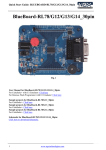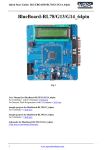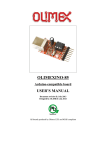Download Hybrid Solar Inverter TP1501 User Manual
Transcript
Hybrid Solar Inverter TP1501 User Manual IMPORTANT SAFETY INSTRUCTIONS SAVE THESE INSTRUCTIONS To reduce the risk of electrical shock and to ensure safe installation and operation of Hybrid Solar Inverter, please carefully read and strictly follow all safety instructions and cautionary markings. CAUTION — Risk of Electric Shock – Plates are live. Disconnect before servicing. CAUTION — Risk of Electric Shock , Do NOT Remove Cover. No User Serviceable Parts Inside. Refer Servicing To Qualified Service Personnel. WARNING — For Continued Protection Against Risk Of Fire, Connect the Grid INPUT(2 black wires) with 20A circuit breaker or fuse. CAUTION — To reduce the risk of electric shock and fire – Do not connect the Hybrid OUTPUT(2 red wires) to ground. CAUTION — Be sure the polarity of PV wires. The RED wire is connected to the positive polarity of the PV string. The BLACK wire is connected to the negative polarity of the PV string. The mistake may cause the damage or fire. CAUTION — To reduce the risk of electrical shock, disconnect both AC and DC power from the Hybrid Inverter before attempting any maintenance or cleaning or working on any circuits connected to the inverter. Turning off controls will not reduce this risk. Internal capacitors remain charged for 5 minutes after disconnecting all sources of power. WARNING — All electrical installation shall be done in accordance with local and national codes ANSI/NFPA 70. WARNING — Connecting this unit to the electrical grid shall only be performed by qualified personnel and only after formal approval from the utility company. WARNING — This device contains no user serviceable parts inside. Please return the unit to authorized Service Center for maintenance. CAUTION — This unit should be mounted on firm background and under a shading roof to avoid exposure to direct sunlight and rain. CAUTION — Rear heat sink of this unit may exceed 80 °C (175°° F ). Don’t touch to avoid risk of burning. Page 1 Table of contents 1. Introduction 2. Installation 3. Wiring process 4. Operating procedure 5. Specifications 6. LED indication 7. Monitoring system 8. Trouble shooting Page 2 1. Introduction The system is a Hybrid photovoltaic inverter. The 2 hybrid sources are Photovoltaic(PV) & Grid power. There is no expensive and bulky batteries required. Hence, eliminating large expenses on battery maintenance. It can convert Photovoltaic DC energy via solar panel modules and invert collected energy into alternate current(AC), which then output to the certain home appliances that are proudly powered by solar, renewable energy. Once the PV energy is not good enough for the appliances, the Grid power will support the rest of the energy automatically. In case of the electric blackout, the Grid power is no longer supporting the rest energy once the PV energy become weak. The power support to the home appliances need to be reduced dependent on the # of the PV panel installed & the sun condition. Unplug some appliances to keep some important ones in this condition. This is not a Grid-tied PV inverter. There is no risk of the PV energy fed into the grid power. Hence, it is sure the TP1501 make the PV panels on the rooftop energize the home appliances under the roof possible with safety & the lowest cost. The TP1501 can operate for 110Vac, 50/60Hz, 220Vac, 50/60Hz, It can automatically synchronize the voltage & frequency of Grid Power. The TP1501 Hybrid PV inverter system can be monitored remotely via software. It provides users with convenient power monitoring and recording functions without the need of additional monitoring systems. AC disconnect DC BOX AC plug for Aircon, Refrig, TV and LED * The traditional Air Conditioner without Inverter inside is not recommended as the Load Page 3 2. Installation Warning : All electrical installation shall be done in accordance with local codes and national odes ANSI/NFPA 70. Warning : Connecting the TP1501 to the electrical grid shall only be performed by qualified personnel and only after formal approval from the utility company. TP1501 can be installed indoor where sufficient air circulation is available with ambient temperature less then 50℃. Outdoor installation should be under controlled environment where no direct sunlight would reach, as excessive heating would damage internal components and should minimize exposure to rain despite her high protection class NEMA 3R. The unit should be installed in a location normally inaccessible to persons. Please install this unit at eye-height (over 1 meter), so that all information and status from LED can be read easily. Mount only on firm background and with correct position as below : Page 4 Mounting of TP1501 Place the metal fixing plate on the designated surface of the wall and mark the holes of the screw. Drill the holes and hammer in the wall anchors. Place the metal fixing plate again and fasten the eight screws into their respective holes. Metal fixing Metal fixing plate Mount the unit on the fixing plate. Be sure that the four hooks get into their respective fixtures and settle down Page 5 Placement of TP1501 Step1 : The screws will bracket fixed to the wall. Step2 : The TP1501 are installed on the bracket. Step 2 Step 1 Step3 : The TP1501 is fixed on the wall Page 6 3. Wiring process PV OUTPUT GRID 60-150Vdc for 110Vac output 1500W@110Vac 90-125 AC 50/60Hz 60-300Vdc for 220Vac output 3000W@220Vac OR 190-245 AC 50/60Hz WARNING —Follow local electrical codes and the National Electrical Code (NEC), ANSI/NFPA 70. Use copper conductors only with minimum 12AWG , 105℃ , 600V wire for power grid and minimum 12AWG , 105℃ ,600V wire for solar panel connections with the PV-Inverter. Power cable selection: AC wire: Black copper wires of 12 AWG or above should be used for alternate current input. Output wire: Red copper wires of 12 AWG or above should be used for alternate current output. DC wire: For PV input from solar panels, the cross section area is dependent on the length of the wire. Identifiable colored copper wires of 11 AWG(section size 4.0mm2) or above. Connect the most positive point from the panels to the red wire of the PV input of TP1501 & the most negative point to the black wire of the PV input of TP1501. NEC 2008 / UL 4703 approval PV wire is recommended. Turn on procedure : Apply the grid power first & then after the green LED active, apply the PV power. & then turn on the appliances Turn off procedure : Turn off the appliances. Remove the PV power & then remove the grid power. Page 7 Recommended wiring Diagram PV Panels DC BOX Extension wire(4) Hybrid Inverter TP1501 110/220 50/60Hz 20A Breaker AC Plug Page 8 Note : The AC wiring concept ; Disconnect the wire between the circuit breaker & load. & then connect the circuit breaker to the Grid input of the TP1501 & connect the load to the output of TP1501 5. Specifications Page 9 6. LEDs indication Green LED : light in Hybrid mode, Blink in PV only mode Amber LED : light when system failed such as grid voltage out of range or output over current, system shutdown & will try to restart again after 1 minute. Yellow LED : display PV status, blinking when the PV panel’s maximum power point tracked Page 10 7. Monitoring system There are 2 monitor system for TP1501, one run on Microsoft Windows, XP or above version for Personal Computer(PC) , the other run on Android for smart phone. The display of the PC is as below : A. Main Page 1. Solar vs. Grid ratio: display the percentage of the power from solar & grid for supplying load 2. Display the real-time power of the solar & grid supply to the load by wattage(W) 3. The local electricity cost $/KWH, User can change this value by double clicking it. 4. Link the history data to Microsoft Excel or Open Office Excel. Double click the button to enable it. 5. Energy(WH) of solar vs. Grid by hour. Updated everyday. Page 11 B. Parameter Page In this page, user can setup the voltage & frequency during the grid power is blackout (PV only mode), there are 5 options : no output, 110V 50Hz, 110V 60Hz, 220V 50Hz, 220V60Hz Check the local dealer, if you want to change it. Page 12 C. How to enable the Bluetooth communication 1. 2. 3. 4. 5. Click the right button while point to the Bluetooth icon in your PC. Select the Add device option. Computer will find the new Bluetooth device named HC-06 Pair HC06 with your computer by code 1234 After the Bluetooth successfully installed. Right click the HC-06 & then select the property & select the “Hardware” to find which COM port that linked with HC-06. For example COM10 or COM 27. 6. Open the setting.INI file of the Monitoring fold in the CD enclosed with the TP1501 package Page 13 7. Replace the COM26 by the COM port that linked with Bluetooth, & then save the file Page 14 8. Double click the Aircon.COM to enable the Display program 9. There will be “The com port open success” shown on the bottom line Page 15 The Display on Android How to enable APP? 1. Setup your smart phone to find Bluetooth device, name HC-06 & then pair it by code 1234 2. Install the APP program, *.apk in your CD. 3. Enabling the APP named BT, the above screen will appear. 4. Click Discovery & then you will find HC-06. 5. Click the HC-06 6. The information shows solar power, grid power & the ration of Solar vs. grid. Page 16 Trouble shooting : 1. No LED active & no output . It may take about 30 seconds for the system initialized every time when the grid power first applied. After that, the green LED will be active. If the green LED doesn’t light. Check the connection of the grid power. 2. No output & the middle amber LED active : a. Disconnect the output load to check if the amber LED off after one minute. b. Check if the input voltage is not in the range 90V~125V, 190V~242V. 3. Solar doesn’t generate power( yellow LED not active in the day time): In the day time, if the bottom yellow LED blinking, which means the solar is generating the power. If the yellow LED is not active in the day time, please check the connection of the PV panels. Page 17


























